Nestled in the folds of southwestern Sichuan lies a land shaped by mountains, rivers, and the eternal flame. When the Torch Festival’s fires flicker against the night sky, and the aroma of tuotuorou (Yi-style braised pork) wafts through the village courtyards, Liangshan embraces visitors with a fervent warmth – a place where the mystique of Yi culture and the grandeur of alpine canyons ferment into a robust cup of ganguanjiu (corn liquor). Here, at every turn, the “Yi Cultural Corridor of China” awaits to collide with your senses, an eternal “Great Liangshan” that ignites the soul and tantalizes the taste buds.
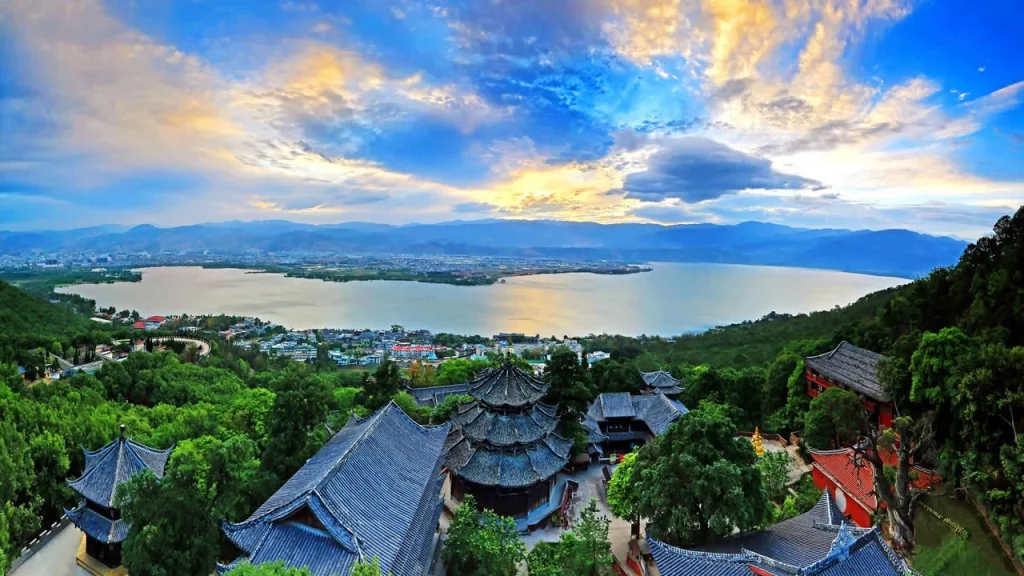
Chapter 1: City Sketch: The “Yi Homeland” Nurtured by the Hengduan Mountains
Liangshan Yi Autonomous Prefecture, nestled in southwestern Sichuan, shines as a pearl nourished by the Hengduan Mountains. As China’s largest Yi ethnic settlement, it unfurls a three-dimensional tapestry of Yi culture across 60,400 square kilometers – a landscape where the majestic Luoji Mountain, the gentle Qionghai Lake, the enigmatic Lugu Lake, and a 2,000-year Yi civilization converge.
The prefecture comprises 2 cities and 15 counties: Xichang City, the capital, cradles the Qionghai Wetland like a jewel; Zhaojue County serves as the cultural heartland, showcasing dazzling Yi attire, silverware, and lacquerware; Yanyuan County boasts the famed Lugu Lake, where the Mosuo people’s “walking marriage” tradition sparks curiosity; and Muli County earns its nickname as the “Last Shangri-La,” with Tibetan Buddhist chants echoing through its canyons. Perched on the eastern edge of the Qinghai-Tibet Plateau, Liangshan enjoys 2,200 annual sunshine hours, distinct seasons, mild winters, and cool summers – an environment that seems to hum with the Torch Festival’s fiery energy even in its very air.
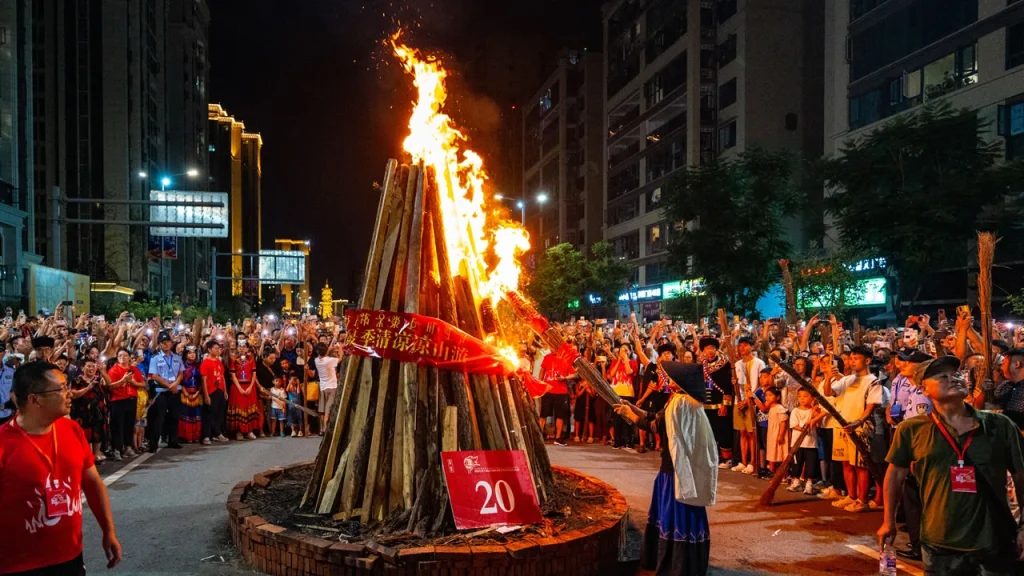
Chapter 2: Historical Tapestry: A Millennium-Long Echo from “Guhou Qunie” to “Yi Homeland of China”
The history of Liangshan is a saga etched in flames and epics. As early as the 2nd century BCE, the ancestral Yi tribes of Guhou and Qunie thrived here; during the Tang Dynasty, the establishment of Yuexi Commandery marked the region as a vital hub on the Southern Silk Road. By the Ming and Qing dynasties, the Yi chieftain system had matured, preserving traditions like Bimo culture and the Torch Festival across generations. The 1952 founding of Liangshan Yi Autonomous Prefecture breathed new life into Yi heritage.
Yet it is the age-old Torch Festival that truly propelled Liangshan to global fame. From the chants of the Yi epic Le E Te Yi to the flames of the festival’s revelry, from the pageantry of beauty pageants, bullfights, and wrestling matches to the melodies of the Duoluohe dance, Liangshan has carved the name “Yi Homeland of China” into the world’s memory through this blazing celebration.
Chapter 3: Geographic Cipher: A Symphony of Mountains and Lakes
Unfold Liangshan’s geographic masterpiece, where the magic of 27°N latitude reveals itself:
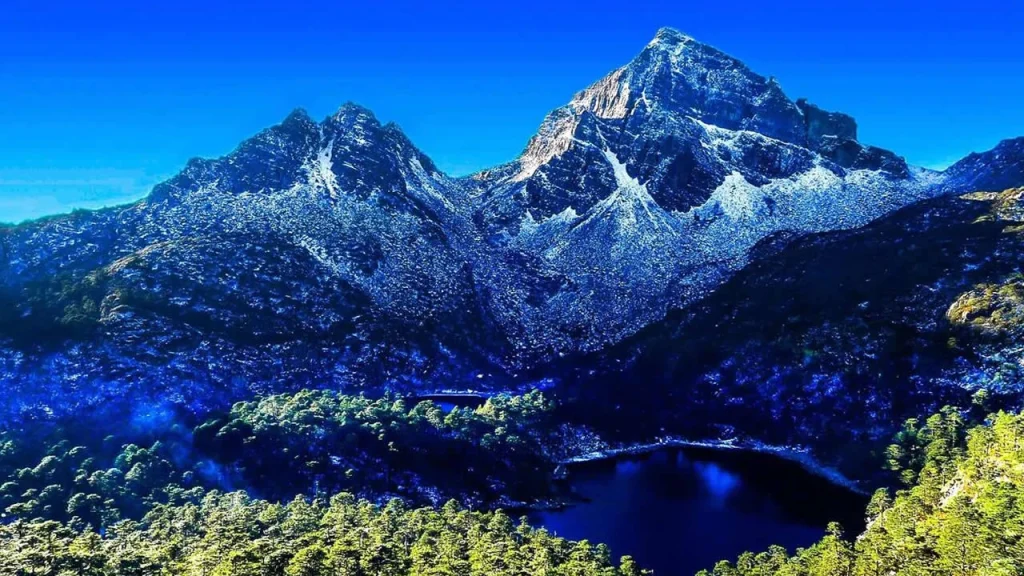
- Luoji Mountain: Sister to Emei Mountain, this peak claims the title of “World’s Largest Hot Spring Waterfall.” The 99-Li Hot Spring Waterfall cascades like a silver river, while glacial lakes gleam like emeralds. Ascend Heilongtan (Black Dragon Pool) by cable car, and watch mist churn beneath your feet – a surreal experience that feels like floating in a “celestial realm.”
- Lugu Lake: This “Pearl of the Plateau” earns its nickname as the “Eastern Kingdom of Women.” Sapphire-blue waters cradle Mosuo pig-trough boats, which drift like fallen leaves. Sail past Leiwubi Island’s prayer flags and Rige Peninsula’s mirrored shores, and sense the mystery of the Mosuo’s unique “walking marriage” tradition.
- Qionghai Wetland: A “Southern Sichuan paradise” and Sichuan’s second-largest freshwater lake, this wetland unfolds like a living painting. Migratory birds flock in kaleidoscopic clouds, and fishing boats sing to the setting sun. Cycle along its shores, trace the curves of Moon Bay and the upturned eaves of Qinglong Temple, and breathe in the freshness of Xichang’s “lungs.”
Chapter 4: A Culinary Journey Through Liangshan: From Tuotuorou to Ganguanjiu
In Liangshan, dining is a feast in motion – a sensory expedition where the richness of tuotuorou (Yi-style braised pork) meets the boldness of ganguanjiu (corn liquor), and the delicate aroma of buckwheat pancakes collides with the tangy heat of pickled pepper chicken feet. Your taste buds are about to traverse mountains and valleys.
Must-Try Flavors of Liangshan
- Tuotuorou (Yi-Style Braised Pork)
This dish reigns as Liangshan’s “Yi Culinary Crown Jewel.” Cubes of pork or beef are simmered with chili, Sichuan pepper, and mujiangzi (Litsea cubeba) until tender. Served with hearty broth, pickled vegetable soup, and buckwheat buns, it embodies the Yi people’s ultimate hospitality. Recommended Spots: Yijia Banquet Hall or Asiniuniu Restaurant – where you can feast like a local, meat in one hand and liquor in the other.
- Ganguanjiu (Corn Liquor)
Dubbed the “Yi Moutai,” this liquor is brewed from sorghum, corn, and buckwheat. Drinkers insert a straw into a clay jar and sip directly – a ritual that deepens with each shared toast. Smooth yet potent, with a lingering sweetness, it’s indispensable at Torch Festivals and Yi New Year celebrations. Recommended Spots: Yizu Renjia (Yi Family Home) or Bimo Manor – where a single sip of freshly tapped ganguanjiu captures the essence of Yi generosity.
- Kuqiaobing (Buckwheat Pancake)
Liangshan’s “Health Elixir” fuses buckwheat flour with eggs and milk, fried to golden perfection. Crispy yet fragrant, these pancakes are prized for regulating blood pressure and blood sugar. Recommended Spots: Xichang Torch Square or Qionghai Hotel – pair them with ganguanjiu for a guilt-free indulgence.
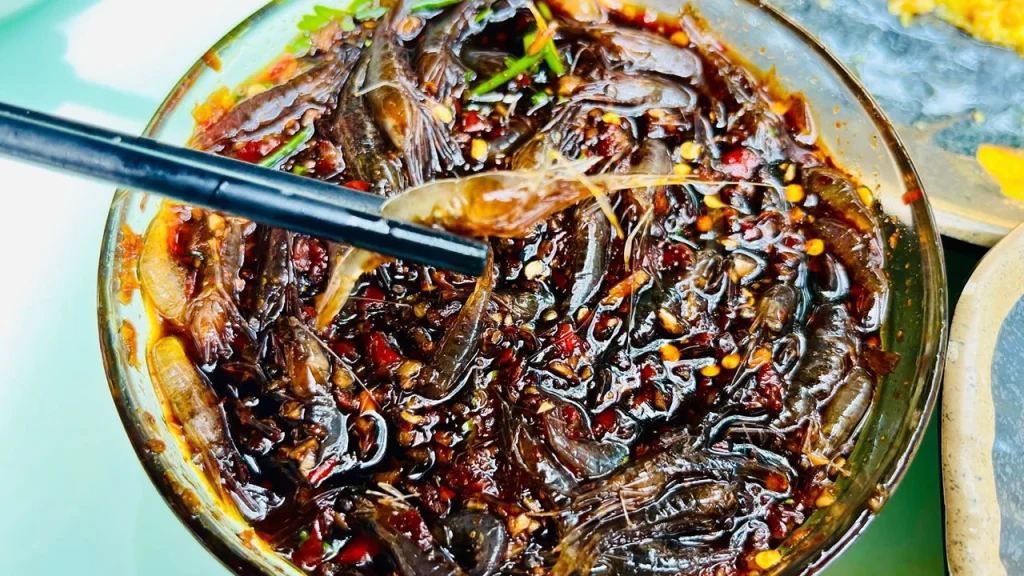
- Drunken Shrimp
This dish is Qionghai’s “umami bomb.” Freshwater river shrimp are marinated in baijiu (Chinese liquor), chili, and Sichuan pepper. The shrimp emerge tender with a bold wine aroma – Xichang locals’ ultimate drinking companion. Recommended Spots: Qionghai Xiaoyucun (Little Fishing Village) or Yujia Weidao (Fisherman’s Flavors) – where spicy-tangy flavors will leave you craving more.
- Yi-Style Sour Vegetable Soup
This soup is Liangshan’s “appetizer essential.” Sour cabbage, potatoes, and turnips simmer with chili and pepper, creating a tangy broth that’s the perfect foil for tuotuorou’s richness. Recommended Spots: Yijiale (Yi Family Joy) or Asiniuniu Restaurant – where one spoonful of sour soup paired with tuotuorou completes a Yi feast.
Culinary Hotspots
- Xichang Torch Square: Liangshan’s “culinary United Nations” – sample tuotuorou, ganguanjiu, and drunken shrimp in one vibrant plaza.
- Qionghai Xiaoyucun: A lake-fresh paradise where drunken shrimp, grilled fish, and silver fish omelets come with a side of lakeside views.
- Zhaojue Yi Cultural Town: Yi flavor central – sour vegetable soup, kuqiaobing, and ganguanjiu line the streets of this ethnic enclave.
Chapter 5: Traveler’s Bible: 100 Ways to Experience Liangshan
- Torch Festival Revelry
On the 24th day of the sixth lunar month, Liangshan transforms into a “city that never sleeps.” At Xichang Torch Square, Zhaojue Gukede, and Butuo Bazi, flames snake through the darkness like dragons, and dancers surge in waves. Join the Douze ritual, dance the Dati dance, and ignite your senses at this “Oriental Carnival.”
- Luoji Mountain Trek
Embark from Luoji Mountain Town, winding through Heilongtan (Black Dragon Pool), Pearl Beach, and Xiancao Lake (Fairy Grass Lake). For the adventurous, conquer glacial peaks and hot spring waterfalls while mist swirls beneath your feet. Recommended Route: Luoji Mountain Town → Heilongtan → Xiancao Lake – discover the grandeur of “Emei’s Sister Mountain.”
- Lugu Lake Circuit
Cycle or hike around Lugu Lake, starting from Rige Peninsula. Marvel at Leiwubi Island’s prayer flags, the Walking Marriage Bridge over the grassy marsh, and Goddess Bay’s sunset. Recommended Route: Rige Peninsula → Walking Marriage Bridge → Goddess Bay – unravel the mysteries of the “Kingdom of Women.”
- Yi Ethnic Attire Immersion
Adorn a Yi pleated skirt, tie a Yingxiongjie (Hero’s Knot) headpiece, and wander Zhaojue Gukede. In Yi Cultural Town, witness silversmiths, lacquer artists, and weavers at work – a journey through the “Yi Cultural Corridor of China.”
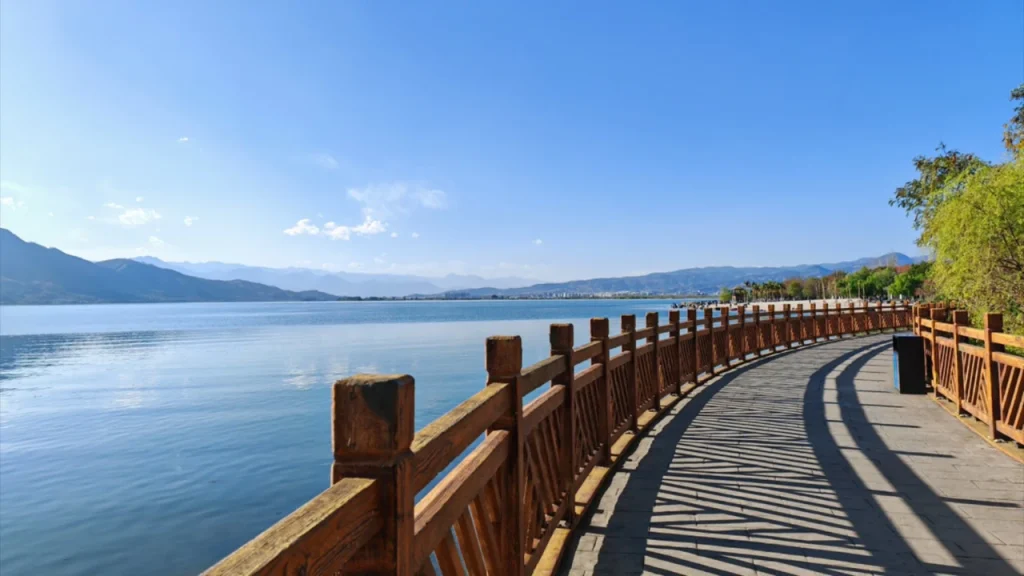
- Qionghai Wetland Cycle
Rent a bicycle and pedal around Qionghai Lake. Trace Moon Bay’s curves, Qinglong Temple’s upturned eaves, and Golden Scale Beach’s sunset. Recommended Route: Qionghai Park → Qinglong Temple → Golden Scale Beach – breathe in the freshness of “Southern Sichuan’s Paradise.”
Chapter 6: Liangshan’s Climatic Code: Gifts of the Subtropical Highland Monsoon
Liangshan enjoys a subtropical highland monsoon climate with four distinct seasons. Winter (November–February) is dry and crisp – ideal for escaping the cold; spring (March–May) bursts with blooming flowers, painting Luoji Mountain’s azaleas in rosy hues; summer (June–August) brings rain, but post-storm skies often frame rainbows, and Qionghai Lake swells with rainwater; autumn (September–October) offers crisp air and azure skies, perfect for admiring Lugu Lake’s waters and maple foliage.
Travel Tips:
- Sunscreen is a must year-round.Pack rain gear for summer and warm layers for winter.Altitude sickness precautions are advised for highland areas.
Epilogue: Liangshan – An Unfinished Torch Saga
When the last sunset bleeds into Luoji Mountain’s snow-capped peaks, and the Torch Festival’s flames once again illuminate the night sky, Liangshan casts its spell – turning every passerby into a pilgrim. Here, time is not a fleeting river but a solidified amber, preserving the chants of Yi epics, the revelry of the Torch Festival, and the richness of tuotuorou. This is a land where fire and history intertwine, waiting to etch its story into your soul. 🔥✨

Leave a Reply